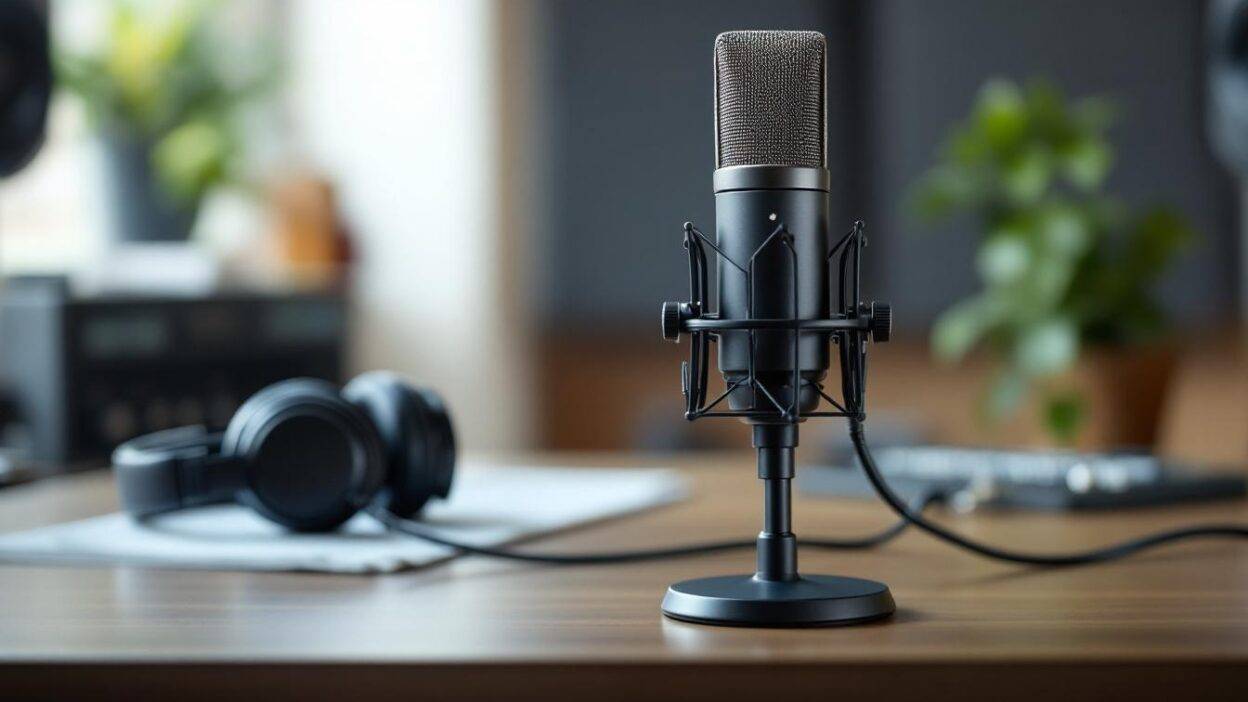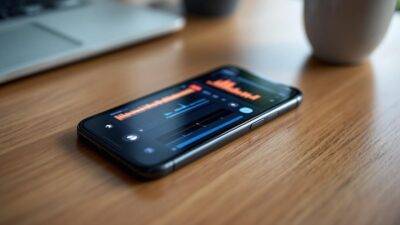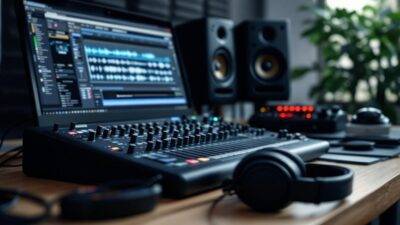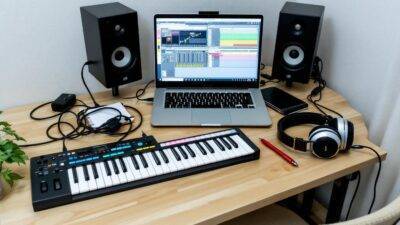Choosing the right music production microphone can make or break your recordings. At Edm, we understand the importance of this decision for producers and musicians alike.
In this guide, we’ll explore the key factors to consider when selecting a microphone for your studio setup. We’ll also provide top recommendations to help you find the perfect mic for your specific needs and budget.
What Are the Main Types of Microphones?
Dynamic Microphones: The Workhorses
Dynamic microphones tend to have lower sensitivity compared to condenser mics, meaning they require more sound pressure to produce the same output level. They boast robustness, handle high sound pressure levels, and resist moisture. These qualities make them perfect for live performances and recording loud sources (such as drum kits or guitar amps). The Shure SM57 exemplifies this category, with widespread use in miking guitar cabinets and snare drums. Its durability and effectiveness have cemented its place as a studio staple for decades.
Condenser Microphones: The Detail Capturers
Condenser microphones offer sensitivity and a wide frequency response. They excel at capturing nuances in vocals and acoustic instruments. These mics require phantom power to operate. The Audio-Technica AT2020 has gained popularity for its balanced sound and versatility. It performs particularly well when recording vocals and various instruments in a studio setting.
Ribbon Microphones: The Vintage Sound Specialists
Ribbon microphones provide a warm, natural tone often described as “vintage.” Classic ribbon mics have a lower output level than contemporary condenser mics, and their greater sensitivity to input impedance can make them more challenging to use. They capture the depth of vocals and certain instruments (particularly brass and woodwinds) exceptionally well. However, they demand more careful handling than dynamic mics. The Royer R-121 represents a modern classic in this category, known for its ability to tame harsh high frequencies while maintaining clarity.
USB Microphones: The Plug-and-Play Options
USB microphones have risen in popularity due to their convenience, especially among beginners and content creators. They connect directly to your computer without an audio interface. The Blue Yeti stands out as a well-known USB mic that offers multiple polar patterns, making it versatile for different recording scenarios. While USB mics offer convenience, they typically don’t match the audio quality of professional XLR microphones.
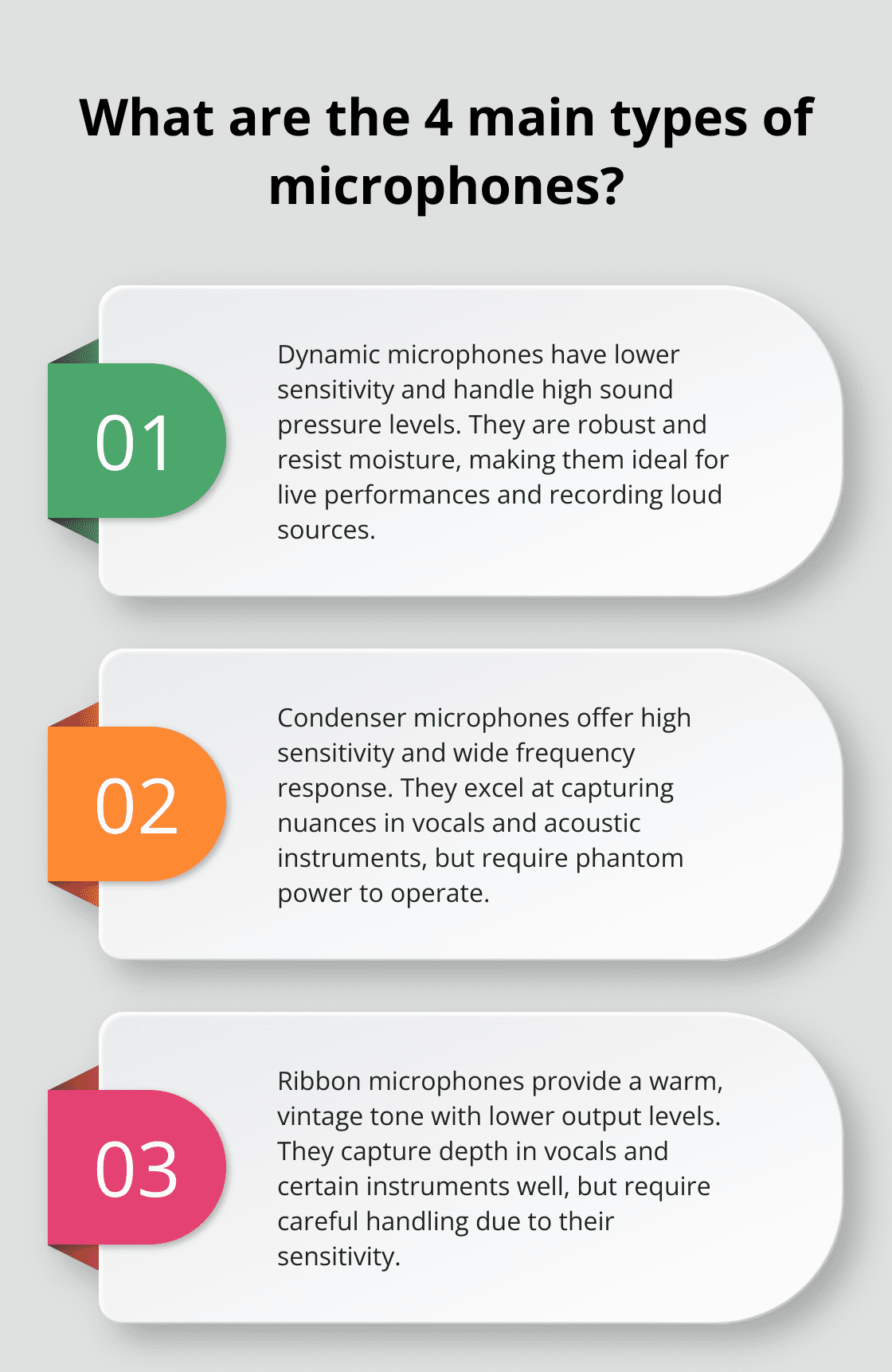
Each microphone type has its strengths and ideal applications. Your choice should depend on your recording needs, budget, and environment. Experimentation with different microphones can help you find the perfect match for your specific requirements and desired sound. As we move forward, let’s explore the key factors you should consider when choosing a microphone for your music production setup.
Key Factors to Consider When Choosing a Microphone
Matching the Mic to Your Recording Needs
The first step in selecting the right microphone involves identifying your primary recording subjects. Different sources require specific microphone characteristics. Large-diaphragm condenser microphones capture vocal nuances effectively, while dynamic mics (such as the Shure SM57) excel at handling high sound pressure levels from snare drums and guitar cabinets.
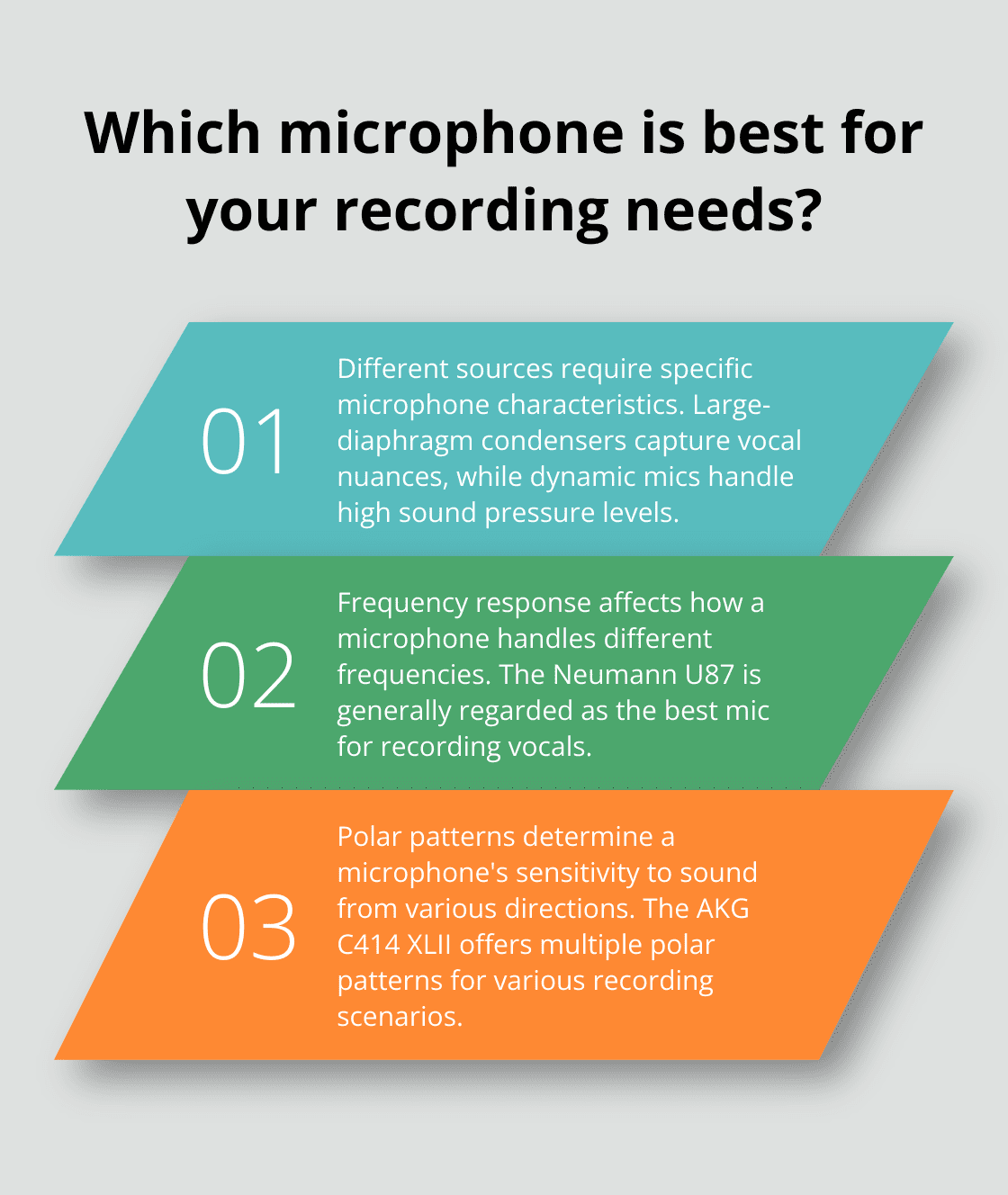
Vocalists should prioritize a high-quality condenser microphone. Podcasters or voiceover artists might prefer a dynamic microphone like the Shure SM7B for its broadcast-quality sound and background noise rejection capabilities.
Understanding Frequency Response
Frequency response describes how a microphone handles different frequencies across the audible spectrum. A flat frequency response captures all frequencies equally, ensuring accurate recordings. Some microphones have a “colored” response, emphasizing certain frequencies for creative effect.
The Neumann U87, for instance, is generally regarded as the best mic to record vocals. Condenser microphones have a wider frequency response than dynamics. Ribbon microphones often provide a smoother high-end response, flattering harsh sources like brass instruments or drum overheads.
The Importance of Polar Patterns
A microphone’s polar pattern determines its sensitivity to sound from various directions. Cardioid patterns, most sensitive to sound from the front, offer versatility in studio recording. They help reject off-axis sounds, reducing unwanted room reflections.
For stereo recording techniques or capturing room ambience, consider microphones with switchable patterns. The AKG C414 XLII offers multiple polar patterns, allowing adaptation to various recording scenarios.
When recording in suboptimal acoustic environments, hypercardioid or supercardioid patterns provide even more off-axis rejection, helping to isolate your sound source.
Sensitivity and SPL Handling
Microphone sensitivity refers to its output level for a given input sound pressure. High-sensitivity microphones (often condensers) excel at capturing quiet sources, while low-sensitivity mics (typically dynamics) handle loud sources without distortion.
Maximum SPL (Sound Pressure Level) indicates the loudest sound a microphone can handle before distorting. For recording loud sources like drum kits or guitar amplifiers, choose microphones with high SPL handling capabilities.
Budget Considerations
Quality microphones range from affordable to extremely expensive. While high-end microphones often provide superior sound quality, many budget-friendly options deliver excellent results. The AT4033, for example, is a solid mid-sized condenser with its own flavor at an extremely good price point, and can easily be had under $200.
Invest in the best microphone your budget allows, but don’t overlook the importance of proper mic technique and a well-treated recording space. These factors significantly impact your recordings, regardless of the microphone’s price tag.
As we explore microphone selection, let’s now turn our attention to specific recommendations for various recording scenarios and budgets.
Top Microphone Picks for Music Production
The Swiss Army Knife: Shure SM7B
The Shure SM7B stands out as a versatile dynamic microphone. It is built to last and has a rich and clear sound. This iconic microphone feels at home on electric guitars and horns, making it ideal for various recording scenarios. Its cardioid polar pattern rejects off-axis sound effectively, making it ideal for home studios without perfect acoustics. The SM7B handles high SPLs well, allowing you to record loud sources without distortion. At around $399, it’s a worthwhile investment for serious producers.
Budget-Friendly Powerhouse: Audio-Technica AT2020
The Audio-Technica AT2020 offers exceptional value for those with a tighter budget. This large-diaphragm condenser microphone delivers a very usable sound. At approximately $99, it’s one of the cheapest studio condenser microphones around. The AT2020 performs well on vocals and acoustic instruments, making it a versatile choice for home studios. (Note that as a condenser microphone, it requires phantom power.)
Vocal Recording Champion: Neumann TLM 103
The Neumann TLM 103 is hard to beat for those who focus primarily on vocal recordings. This large-diaphragm condenser microphone captures the nuances of a vocal performance with remarkable clarity. With a price tag of around $1,100, it’s a significant investment. Its low self-noise and high sensitivity make it ideal for capturing intimate vocal performances. The TLM 103’s cardioid polar pattern helps isolate the vocalist from room reflections, resulting in cleaner recordings.
Instrument Recording Specialist: AKG C414 XLII
The AKG C414 XLII is a top choice for recording instruments. Its multiple polar patterns (cardioid, omnidirectional, figure-8) provide flexibility for various recording scenarios. This versatility allows you to experiment with different mic techniques on guitars, drums, or even as room mics. Priced at about $1,000, it’s a professional-grade microphone that delivers exceptional results across a wide range of instruments.
USB Mic for Beginners: Blue Yeti X
The Blue Yeti X USB microphone is an excellent choice for those just starting out or needing a plug-and-play solution. It offers four polar patterns, on-board controls, and direct computer connectivity without an audio interface. At around $170, it provides good quality for its price point. While it may not match the fidelity of higher-end XLR microphones, its ease of use and versatility make it ideal for beginners or for quick recording sessions.
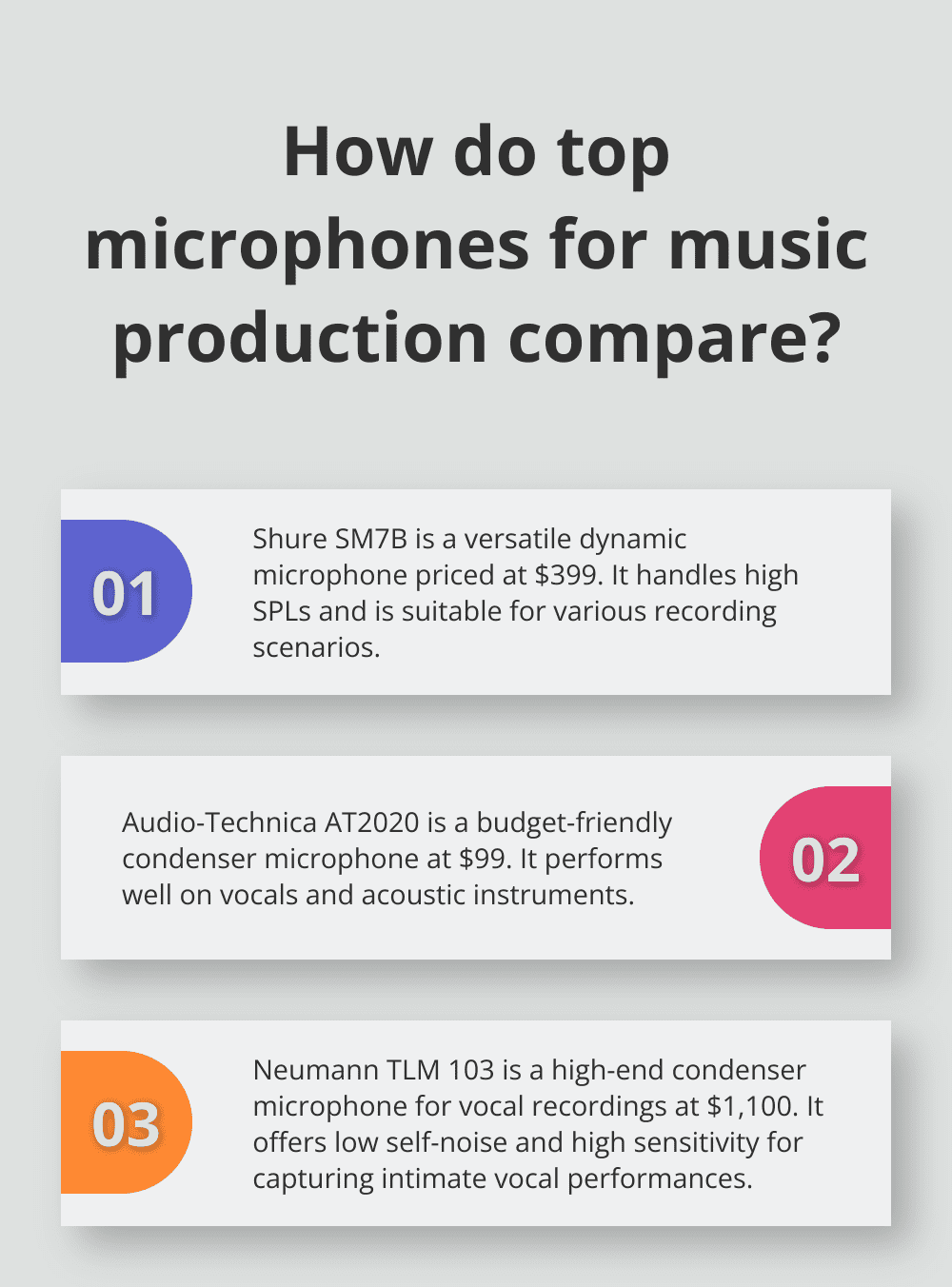
The best microphone for you depends on your specific needs, recording environment, and budget. Try out different microphones if possible, as personal preference plays a significant role in microphone selection. Many music stores offer rental services, allowing you to test various models before making a purchase. (For those looking to enhance their electronic music production skills alongside their microphone selection, Edm offers comprehensive courses and personalized coaching to help you make the most of your gear.)
Final Thoughts
Selecting the right music production microphone will significantly impact your recording quality. We explored various microphone types, each with unique strengths, and discussed key factors to consider when making your choice. Your specific recording needs, frequency response requirements, and budget will guide you to the ideal microphone for your setup.
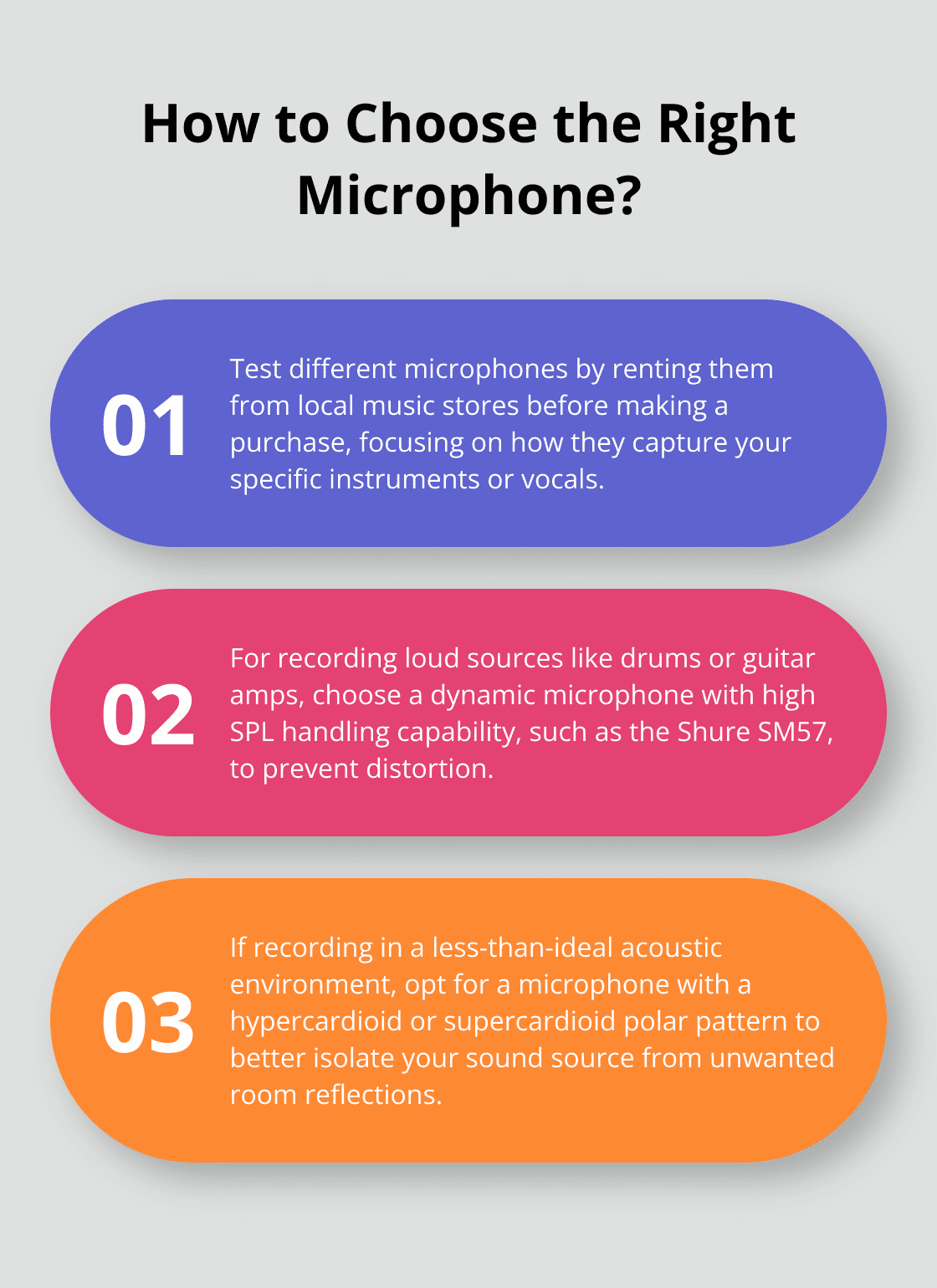
Experimentation with different microphones can lead to surprising discoveries about how they complement your voice or instrument. Many music stores offer rental services, which allow you to test various models before purchasing. A quality microphone can dramatically improve your productions, but it’s just one part of creating great music.
At Edm, we provide a comprehensive platform for aspiring electronic music producers. Our personalized coaching and diverse courses can help you maximize your gear’s potential and enhance your creative skills. Explore our offerings to elevate your music production journey and create professional-quality recordings that stand out in today’s competitive landscape.
